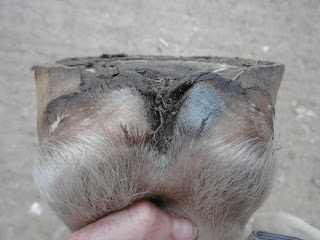With apologies for the massive delay, I am finally posting Flynn's update. My stills camera died so I tried using my other camera but then the SD card conked out. Fourth time lucky here we go... As usual, old photos at the top, new photos below.
So Flynn is now at week 11 of his rehab and has done well - he has been landing heel first for a while and has been working on the roads as well as in the school. The rich flush of grass in August meant I had to be careful with his turnout but he is now back to being out at night which he loves.
Comparing his photos, the most obvious difference is the shorter toe and less under-run heel. The sole shots show better concavity and a better heel balance, whereas he was overloading the lateral heel when he arrived.
Nothing particularly spectacular here, though you can see the lateral heel is lower now and he has a better digital cushion.
From this angle the better support he has now is pretty clear, I think - the whole limb looks a lot more stable.
As with the other foot the main differences now are better medio-lateral balance (he lands more evenly) and a healthier palmar hoof (he lands heel first).
I will try to add Flynn's updated footage when I can recover it but for now you'll have to take my word for it about the improved landings!























